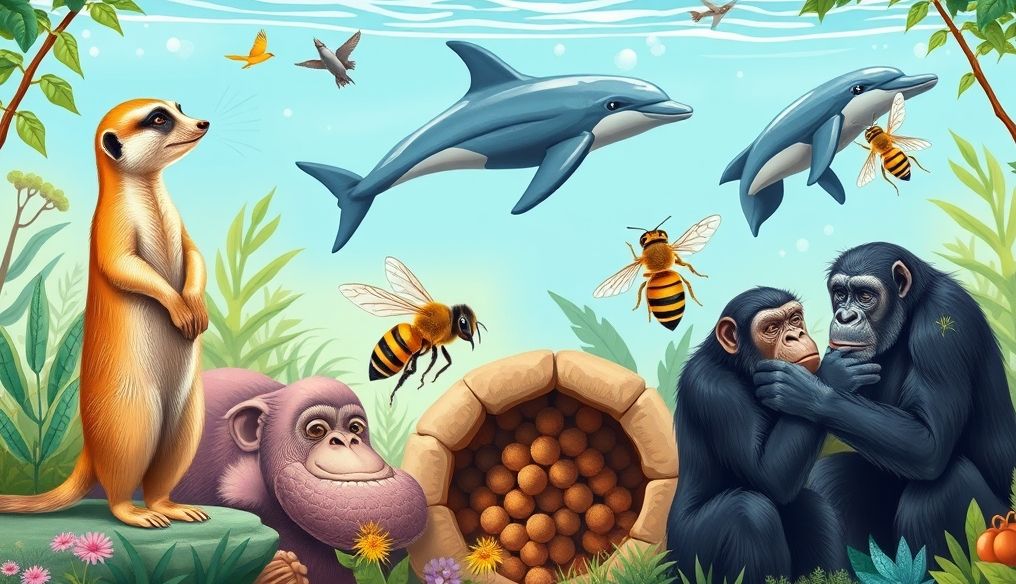Do Animals Communicate with Each Other Using a Special Language? A Deep Dive into the World of Animal Communication
Since time immemorial, communication between animals has intrigued humans. Are they just random sounds, or do they carry complex meanings and messages? Can it be considered a language in the way we understand it? This article delves into the world of animal communication, exploring its forms, complexities, and recent discoveries that have changed our understanding of this field.
1. What is Animal Communication?
Animal communication is any behavior by one animal that affects the behavior of another. This includes a wide range of signals, such as sounds, smells, body movements, and even visual cues. Communication aims to convey information between individuals, whether it's warnings of danger, mating announcements, or simply locating food.
2. Forms of Animal Communication: A Diverse World of Signals
Communication methods among animals vary greatly, depending on the type of animal and its environment:
- Acoustic Communication: Includes barking, roaring, chirping, and even ultrasonic waves used by bats. Humpback whales use complex songs to communicate over long distances.
- Chemical Communication: Animals use pheromones, chemicals released into the environment, for communication. Ants use pheromones to mark food trails, while cats use scents to define their territories.
- Visual Communication: Includes body movements, facial expressions, and colors. Birds use elaborate dances to attract mates, while chameleons change color to express their mood.
- Tactile Communication: Includes touching, mutual grooming, and nudges. Monkeys often groom each other to strengthen social bonds.
3. Can Animal Communication Be Considered a Language?
This is a complex question. Human language is characterized by unique properties, such as the ability to use grammar to create new sentences, and the ability to refer to things that are not present or future (displacement). While some animals show remarkable communication skills, they do not usually possess these properties fully.
However, research has shown that some animals may be closer to human language than we thought:
- Chimpanzees: Some chimpanzees have learned to use sign language to communicate with humans, and even to create simple sentences.
- African Grey Parrots: These parrots have shown an ability to understand and use words correctly, and even answer questions.
- Dolphins: Dolphins have a complex acoustic communication system, and some scientists believe they may have their own language, but it has not yet been deciphered.
4. Complexities of Animal Communication: More Than Just Instincts
In the past, animal communication was thought to rely primarily on instincts. However, recent research has shown that learning plays an important role in the development of communication skills in many animals. For example, young birds learn their songs from their parents, and these songs evolve over time.
5. Importance of Animal Communication: Survival and Success
Communication is essential for the survival and success of animals. It allows them to:
- Avoid Danger: Warn each other of predators.
- Find Food: Locate food sources and share them with others.
- Mate: Attract partners and reproduce.
- Build Social Bonds: Cooperate and live in cohesive groups.
6. Fascinating Examples from the World of Animal Communication
The Complex Alarm System of Meerkats: Meerkats have a highly complex vocal alarm system, emitting different sounds to warn of different types of predators (such as eagles and snakes). There are even different sounds for warning of a predator approaching from the ground versus one approaching from the sky.
The Waggle Dance of Bees: When a worker bee finds a new food source, she returns to the hive and performs a complex dance that tells the other bees the location and direction of the food. The accuracy of this dance depends on the quality of the food source.
7. How Do Scientists Study Animal Communication?
Scientists use a variety of methods to study animal communication, including:
- Direct Observation: Observing animals in their natural environment and recording their communicative behaviors.
- Audio and Video Recording: Recording the sounds and body movements of animals and analyzing them later.
- Laboratory Experiments: Designing experiments to test how animals respond to different communicative signals.
- DNA Analysis: Studying the relationship between genes and communication behavior in animals.
8. Challenges in Understanding Animal Communication
Understanding animal communication faces several challenges:
- Human Bias: It is easy to project our human concepts of language and communication onto animals, which can lead to misinterpretations.
- Complexity of Signals: Communicative signals can be very complex and variable, making them difficult to decode.
- Environmental Conditions: Environmental conditions (such as noise) can affect animal communication.
9. The Future of Animal Communication Research
Animal communication research is an exciting and constantly evolving field. With advances in technology, we are able to study animal communication in ways that were not possible before. This research may help us better understand the minds of animals, our relationship with the natural world, and even the origins of human language.
10. Conclusion: The Amazing World of Animal Communication
Although animals may not communicate in a language in the full human sense, they possess complex and fascinating communication systems that allow them to survive, reproduce, and thrive. Understanding these systems not only enriches our knowledge of the natural world but also helps us appreciate the value of biodiversity and the importance of preserving it.
References:
Hauser, M. D. (1996). The Evolution of Communication. MIT Press.
Bradbury, J. W., & Vehrencamp, S. L. (2011). Principles of Animal Communication. Sinauer Associates.




